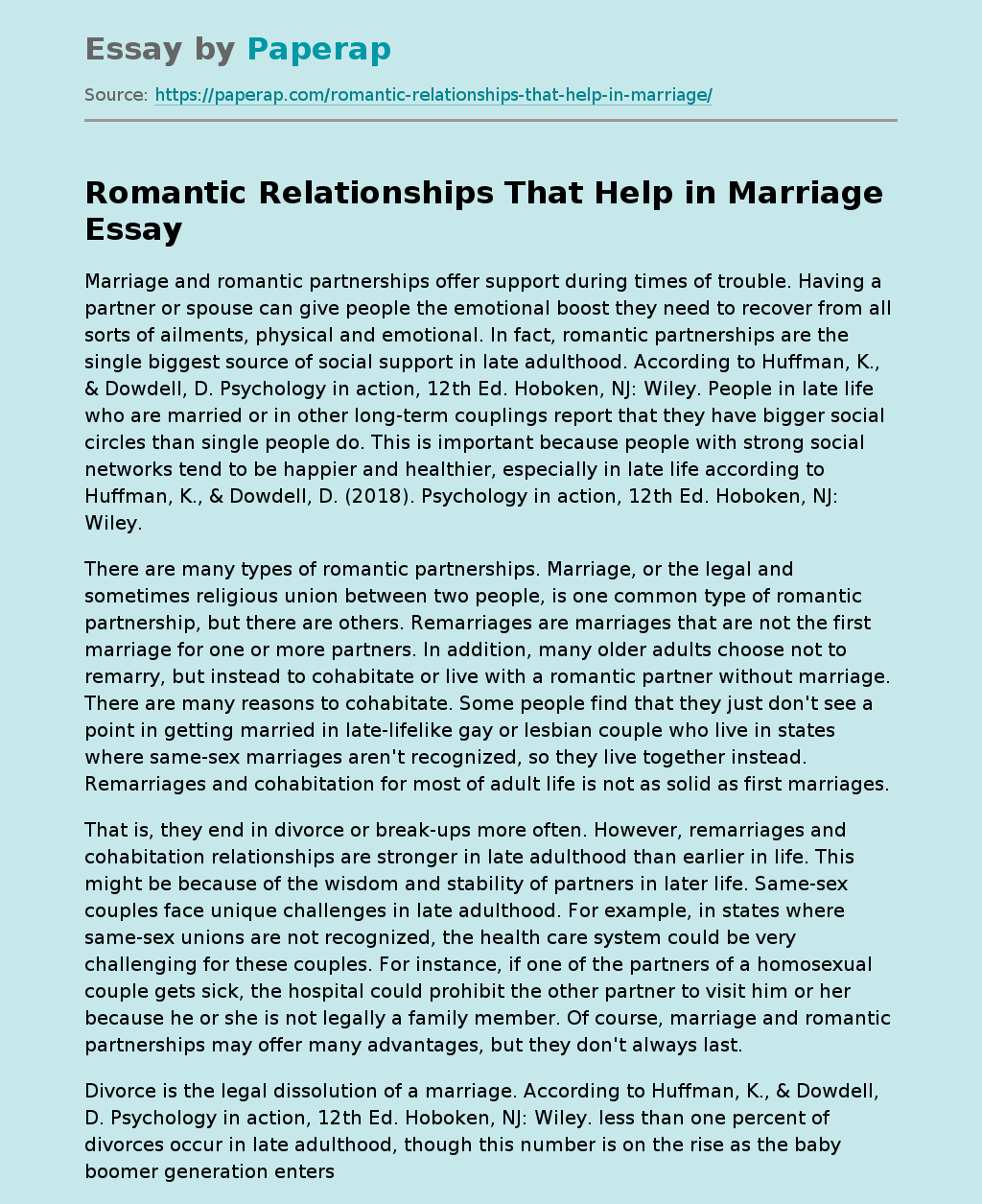Romantic Relationships That Help in Marriage
Marriage and romantic partnerships offer support during times of trouble. Having a partner or spouse can give people the emotional boost they need to recover from all sorts of ailments, physical and emotional. In fact, romantic partnerships are the single biggest source of social support in late adulthood. According to Huffman, K., & Dowdell, D. Psychology in action, 12th Ed. Hoboken, NJ: Wiley. People in late life who are married or in other long-term couplings report that they have bigger social circles than single people do.
This is important because people with strong social networks tend to be happier and healthier, especially in late life according to Huffman, K., & Dowdell, D. (2018). Psychology in action, 12th Ed. Hoboken, NJ: Wiley.
There are many types of romantic partnerships. Marriage, or the legal and sometimes religious union between two people, is one common type of romantic partnership, but there are others. Remarriages are marriages that are not the first marriage for one or more partners.
In addition, many older adults choose not to remarry, but instead to cohabitate or live with a romantic partner without marriage. There are many reasons to cohabitate. Some people find that they just don’t see a point in getting married in late-lifelike gay or lesbian couple who live in states where same-sex marriages aren’t recognized, so they live together instead. Remarriages and cohabitation for most of adult life is not as solid as first marriages.
That is, they end in divorce or break-ups more often. However, remarriages and cohabitation relationships are stronger in late adulthood than earlier in life.
This might be because of the wisdom and stability of partners in later life. Same-sex couples face unique challenges in late adulthood. For example, in states where same-sex unions are not recognized, the health care system could be very challenging for these couples. For instance, if one of the partners of a homosexual couple gets sick, the hospital could prohibit the other partner to visit him or her because he or she is not legally a family member. Of course, marriage and romantic partnerships may offer many advantages, but they don’t always last.
Divorce is the legal dissolution of a marriage. According to Huffman, K., & Dowdell, D. Psychology in action, 12th Ed. Hoboken, NJ: Wiley. less than one percent of divorces occur in late adulthood, though this number is on the rise as the baby boomer generation enters late adulthood. Because the baby boomers don’t hold divorce with as much stigma as earlier generations, there has been a slight uptick in divorce rates in recent years. Still, divorce is relatively rare in late adulthood but can pose some unique challenges. Compared to younger divorcees, people who go through a divorce in late life find it harder to separate their identity from that of their former spouse according to Huffman, K., & Dowdell, D. (2018). Psychology in action, 12th Ed. Hoboken, NJ: Wiley. For example, being married to someone for so long could be very challenging to live without this partner. Further, people who go through a divorce during late adulthood tend to carry more of a sense of personal failure than younger divorced people do according to Huffman, K., & Dowdell, D. Psychology in action, 12th Ed. Hoboken, NJ: Wiley.
In short, late adulthood is the time of life after age 65. During this time, marriage and other types of romantic partnerships can offer a strong sense of support. On the other hand, remarriages and cohabitation tend to be stronger in later life, compared to earlier in adulthood. But gay couples face some challenges when their union is not recognized by the government, especially when it comes to the healthcare system. Finally, divorce is rarer in late adulthood than earlier in life but can cause some people to have trouble separating their identity from their former spouse and to feel a sense of personal failure for the divorce.
Romantic Relationships That Help in Marriage. (2021, Dec 13). Retrieved from https://paperap.com/romantic-relationships-that-help-in-marriage/

